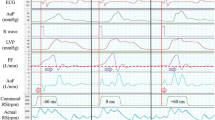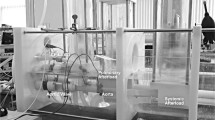Abstract
Control of the ventricular assist device (VAD) for native heart preservation should be attempted, and the VAD could be one strategy for dealing with the shortage of donors in the future. In the application of nonpulsatile blood pumps for ventricular assistance from the ventricular apex to the aorta, bypass flow and hence the motor current of the pumps change in response to the ventricular pressure change. Utilizing these intrinsic characteristics of the continuous-flow pumps, in this study we investigated whether motor current could be used as an index for continuous monitoring of native cardiac function. In study 1, a centrifugal blood pump (CFP) VAD was installed between the apex and descending aorta of a mock circulatory loop. In this model, a baseline with a preload of 10 mmHg, afterload of 40 mmHg, and LV systolic pressure of 40 mmHg was used. The pump speed was fixed at 1300, 1500, and 1700 rpm, and LV systolic pressure was increased up to 140 mmHg by steps of 20 mmHg while the changes in LV pressure, motor current, pump flow, and aortic pressure were observed. In study 2, an in vivo experiment was performed using three sheep. A left heart bypass model was created using a centrifugal pump from the ventricular apex to the descending aorta. The LVP was varied through administration of dopamine while the changes in LV pressure, pump flow, and motor current at 1500 and 1700 rpm were observed. An excellent correlation was observed in both in vitro and in vivo studies in the relationship between motor current and LV pressure. In study 1, the correlation coefficients were 0.77, 0.92, and 0.99 for 1300, 1500, and 1700 rpm, respectively. In study 2, they were 0.88 (animal no. 1), 0.83 (animal no. 2), and 0.88 (animal no. 3) for 1500 rpm, and 0.95 (animal no. 2) and 0.93 (animal no. 3) for 1700 rpm. These results suggest that motor current amplitude monitoring could be useful as an index for the control of VAD for native heart preservation.
Similar content being viewed by others
References
Kyo S, Tanabe H, Asano H, Ohuchi H, Nogaki H, Ishikawa M, Tokote Y, Koyanagi T, Noda H, Omoto R. Clinical effects of ventricular assist system in end-stage cardiac failure. Advantages of left ventricular blood drainage for recovery from cardiac dysfunction. JJTCVS 2000;48:440–446
Westaby S, Jin XY, Katsumata T, Taggart DP, Coats AJS, Frazier OH. Mechanical support in dilated cardiomyopathy: sign of left ventricular recovery. Ann Thorac Surg 1997;64:1303–1308
Frazier OH, Myers TJ. Left ventricular assist system as a bridge to myocardial recovery. Ann Thorac Surg 1999;68:734–741
Hetzer R, Müller J, Weng Y, Wallukat G, Spiegelsberger S, Loebe M. Cardiac recovery in dilated cardiomyopathy by unloading with a left ventricular assist device. Ann Thorac Surg 1999;68:742–749
Tsukiya T, Akamatsu T, Nishimura K, Yamada T, Nakazeki T. Use of motor current in flow rate measurement for the magnetically suspended centrifugal blood pump. Artif Organs 1997;21:396–401
Araki K, Oshikawa M, Anai H, Nakamura K, Satoh M, Yoshihara H, Onitsuka T. Detection and implications of the characteristic points for estimating the assisting condition in a continuous-flow artificial heart—in vitro study. Jpn J Artif Organs 1999;28:388–393
Oshikawa M, Araki K, Anai H, Nakamura K, Satoh M, Onitsuka T. In vivo evaluation of novel control method for a continuous-flow artificial heart. Jpn J Artif Organs 1999;28:320–325
Iijima T, Inamoto T, Nogawa M, Takatani S. Control of centrifugal blood pump based on the motor current. Artif Organs 1997;21:655–660
Hatoh E, Yuhki A, Iseki M, Nogawa M, Takatani S. Detection of suction and regurgitation of the implantable centrifugal pump based on motor current waveform analysis and its application to the optimization of pump flow. Jpn J Artif Organs 1999;28:345–349
Hatoh E, Yuhki A, Nogawa M, Kikugawa D, Murakami T, Takatani S. Automatic control of the implantable centrifugal pump based on motor current waveform analysis: system design and its evaluation. Jpn J Artif Organs 2000;29:351–355
Author information
Authors and Affiliations
Corresponding author
Rights and permissions
About this article
Cite this article
Kikugawa, D., Ohuchi, K., Nakamura, M. et al. Analysis of the relationship between left ventricular pressure and motor current for evaluation of native cardiac function during left ventricular support with a centrifugal blood pump. J Artif Organs 4, 269–272 (2001). https://doi.org/10.1007/BF02480015
Received:
Issue Date:
DOI: https://doi.org/10.1007/BF02480015




